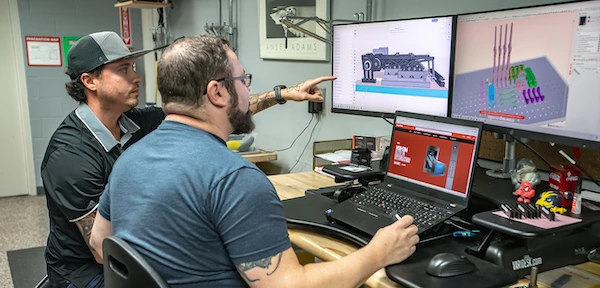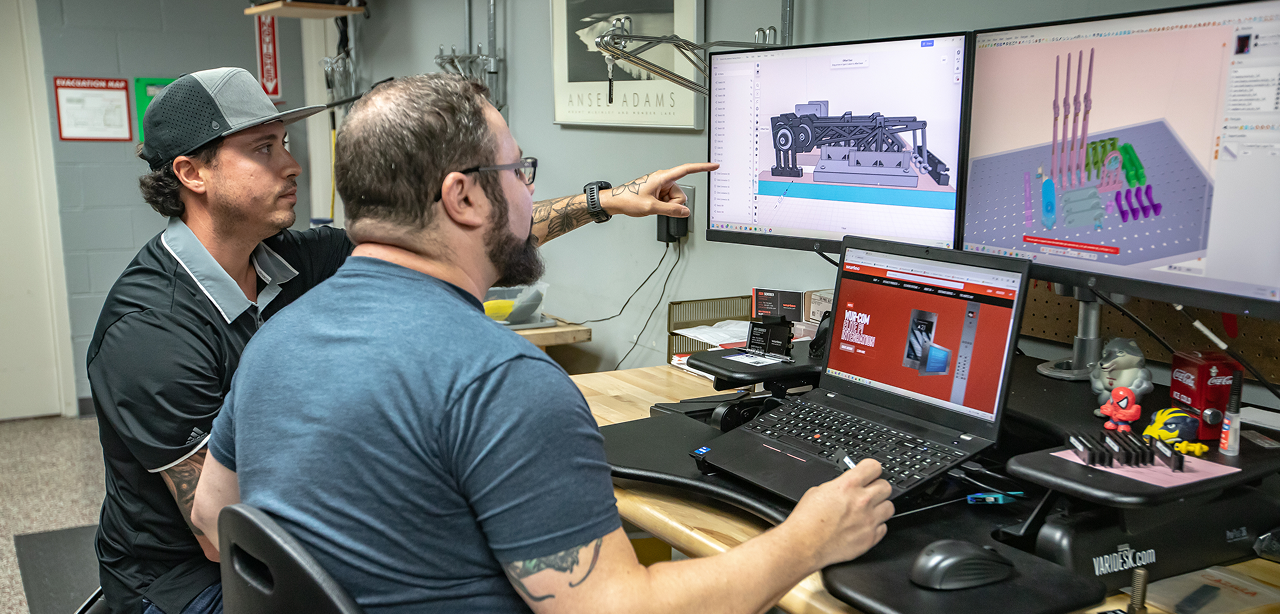The untapped benefits of Augmented Reality for business

Technology is reshaping our world in ways that have, until recently, existed only in the realm of fantasy. Artificial Intelligence (AI), Augmented Reality (AR), and Virtual Reality (VR) are quickly becoming integrated into our daily lives. As the rate of exposure rises, so does the demand for businesses to incorporate these elements into the smart, immersive experiences we are growing to expect.
To successfully adapt to the swiftly changing technological landscape, the time to innovate is now.
So, what can you do to take advantage of these technologies? Why should you dedicate time and resources to do so? How might these tools benefit your business? In this article, we will address these questions from the view of businesses focused on manufacturing and consumer product design. For companies in this arena, Augmented Reality specifically can be a crucial component to positioning your business as an innovative leader in your field. Keep reading to learn:
- What is AR
- AR vs. VR
- AR in Manufacturing
- AR in consumer products
- Implementing AR
What is AR
Augmented Reality, short for AR, combines our real, physical world with digital information. AR can provide an enhanced view of our surroundings, such as overlaying information about points of interest on our current view of a city street. It can alter our view by applying face filters or allowing us to virtually try on items like shoes or clothing.
It can allow us to preview products in their intended environment, such as how that new couch you’ve been considering will look in your living room, or whether that conveyor system will fit on your production floor. It can even deliver an immersive interactive experience to enhance installation or assembly instructions or improve training.
AR vs. VR
So, what’s the difference between Augmented Reality (AR) and Virtual Reality (VR)? Augmented Reality is designed to enhance or add information to a user’s existing surroundings. You can experience it through the lens of a smartphone or tablet camera.
Virtual Reality, on the other hand, is a fully immersive experience where a user is plugged into a virtual environment. To experience Virtual Reality, you will require special VR devices such as goggles, gloves, headsets, etc. Given that most people have access to the equipment needed for Augmented Reality in their pockets, it makes it an accessible and valuable technology that you can provide for your audience.
AR in manufacturing
One of the most innovative ways Augmented Reality has impacted manufacturing is by accelerating in-house training and maintenance. Rather than requiring employees to memorize information or refer to complicated and often out-of-date manuals, AR allows for real-time feedback and instructions on tasks that must be performed. Undeniably, as the complexity of factory floor equipment increases, the systems used by operators and technicians working with these machines also need to become more advanced to allow employees to perform their duties proficiently.

As seen with many industry leaders that have invested in these systems, AR training and instruction systems have allowed manufacturers to reduce the time to bring new team members up to speed, improve production times, and reduce costly errors. According to AR Insider, after Boeing implemented AR in their manufacturing processes,
“Boeing was able to reduce error rates to zero. It also cut its wiring production time by 25 percent.”
And Scope AR quotes Shelley Peterson, an Emerging Technologies Lead at Lockheed Martin, as saying their “… augmented reality platform has tremendously helped our space division build high quality spacecraft by reducing the time it takes to interpret work instructions by more than 95 percent.”
For small to medium businesses, AR drastically decreases concept-to-manufacturing time. Austin Rivera, concept design lead at BrandMotion use Shapr3D's built-in AR function to preview parts in designed for custom vehicles. The company's work brings most of the employees' work right to the shopfloor, which means that they have increased mobility needs when it comes to modeling tools. With Shapr3D running on iPad, Austin and his team can showcase how a custom part, like a dashboard, will look once manufactured - something which makes the whole design process much more realistic.
A new workforce generation is another factor to consider when weighing the benefits of AR. Pioneering manufacturing companies are investing now to prepare for a new generation that has grown up with advanced technologies and likely without the same hands-on expertise as the aging workforce. According to LightGuide, in a survey of frontline workers aged 18-44, 50% stated they would consider leaving their job for a more modern work environment. For businesses that recognize the value of employee retention and want to stand out as a modern workplace, AR systems can be a valuable differentiator.
AR in consumer products
In the consumer products industry, AR is emerging as an extraordinary tool that not only drives customer engagement and enhances e-commerce but has also been shown to increase sales and reduce product return rates. According to Shopify, when fashion brand Rebecca Minkof added the ability for customers to view their products using AR, the stats were irrefutably impressive. Here’s the summary from their blog article The ROI on AR: How Augmented Reality is Boosting Ecommerce Sales:
- Shoppers were 44% more likely to add an item to their cart after interacting with it in 3D
- Customers were 27% more likely to place an order after interacting with a product in 3D
- Visitors were 65% more likely to place an order after interacting with a product in AR
Although these results are just one specific example, multiple studies have shown that AR online shopping experiences positively influence consumer purchasing behavior across various industries.

On top of that, it’s an experience that customers enjoy and are on the lookout for. According to Harvard Business Review, “56% of shoppers surveyed by NielsenIQ said that AR gives them more confidence about the quality of a product, and 61% said they prefer to shop with retailers that offer AR experiences.” The same Harvard Business Review article found that AR usage can significantly impact sales related to lesser-known brands, less mainstream products, and more expensive products.
By providing customers with an immersive and realistic interaction with a product, AR can help them feel more comfortable with a purchase decision that might otherwise feel risky. Some other impressive statistics about AR, according to Exploding Topics, include:
- There are approximately 1.4 billion active AR user devices
- Around 3 in 4 adults under the age of 44 are aware of AR
- AR-based shopping encourages almost half of all consumers to spend more
Implementing AR
One of the amazing things about AR is that if you are involved in manufacturing or consumer product design, there’s a good chance that you can begin using it immediately. Many CAD software packages include AR as a way to visualize your 3D models in real-world environments. Taking advantage of how you can leverage your existing CAD data in available AR viewers can be a great place to start and explore possibilities.
For Shapr3D users, there are three ways to experience models in AR.
You can launch an AR preview directly from the app, export your design to a Review Link, and let others view it on a smartphone, or export your design in a format that is suitable for a 3rd party application such as Microsoft 3D viewer or Adobe Aero. Check out this video for more information or visit the Augmented Reality article in the Shapr3D Manual to learn more about AR.

Visualization mode within Shapr3D’s Review Links includes capabilities that allow shared designs to be viewable in an augmented reality environment through iOS or Android devices.
If you have determined that the time is right to invest in developing a custom AR application, you will find an increasing number of AR development companies competing for your business. The costs for creating a custom AR application can vary significantly depending on the complexity. For instance, Carmatec, an AR app development company, estimates a price tag between $10,000 to $200,000 (USD).
Conclusion
AR is an incredible technology that industry leaders and innovators are already leveraging. For manufacturing, studies consistently show that AR significantly impacts employee training and assistance with task completion, contributing to lower production costs and reductions in errors.
For consumer product design, AR provides a stand-out way to engage customers in the online marketplace and increase sales. With growing demand and awareness, it may be time to investigate how AR can benefit your business. It could be the tool you need to propel your company to the next level.
Technology is reshaping our world in ways that have, until recently, existed only in the realm of fantasy. Artificial Intelligence (AI), Augmented Reality (AR), and Virtual Reality (VR) are quickly becoming integrated into our daily lives. As the rate of exposure rises, so does the demand for businesses to incorporate these elements into the smart, immersive experiences we are growing to expect. To successfully adapt to the swiftly changing technological landscape, the time to innovate is now.








